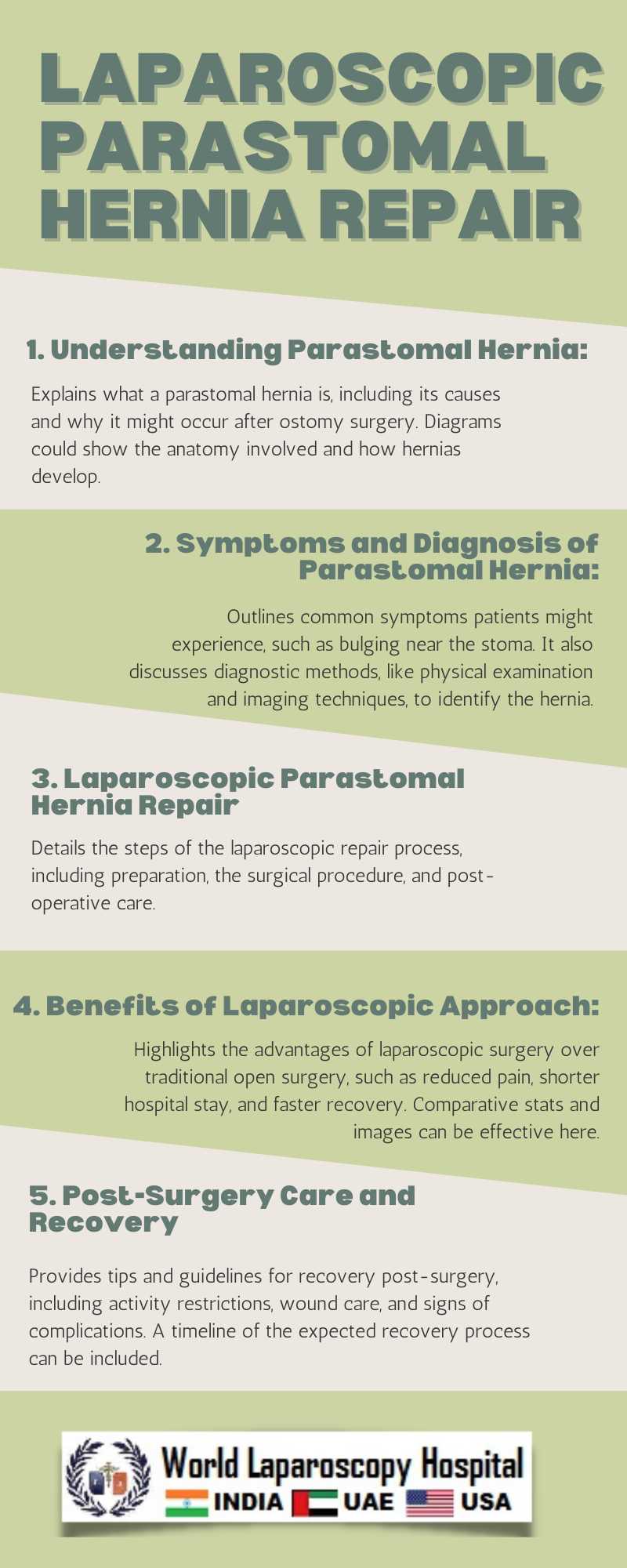Innovative Surgical Techniques: Mastering Laparoscopic Parastomal Hernia Repair
Innovative Surgical Techniques: Mastering Laparoscopic Parastomal Hernia Repair
In the realm of modern surgery, the evolution of techniques has significantly enhanced patient outcomes and recovery times. One such advancement is the laparoscopic approach to parastomal hernia repair. This minimally invasive technique has revolutionized the management of parastomal hernias, offering a blend of precision, minimal discomfort, and rapid recovery.

Understanding Parastomal Hernias
A parastomal hernia is a common complication associated with stoma formation, occurring in up to 50% of cases. It results when the intestine bulges through a weakness in the abdominal muscles around the stoma site. Symptoms can range from discomfort and cosmetic concerns to severe complications like obstruction or strangulation of the intestine.
The Traditional Approach
Traditionally, parastomal hernia repair has been performed using open surgery, which involves a large incision. Although effective, this approach is associated with significant postoperative pain, longer hospital stays, and a high recurrence rate of hernias.
The Laparoscopic Revolution
The laparoscopic technique has emerged as a superior alternative. This approach involves making several small incisions through which a laparoscope and specialized instruments are inserted. The hernia is repaired with the placement of a mesh, which reinforces the abdominal wall and reduces the risk of recurrence.
Advantages of Laparoscopic Parastomal Hernia Repair
1. Reduced Pain and Faster Recovery: Smaller incisions result in less postoperative pain and quicker recovery times.
2. Lower Recurrence Rates: The use of mesh in laparoscopic repairs has shown to significantly lower the rate of hernia recurrence.
3. Enhanced Visualization: The laparoscope provides a magnified view of the internal structures, allowing for more precise repair.
4. Decreased Wound Complications: The minimally invasive nature of the procedure reduces the risk of wound infections and other complications.
Mastering the Technique
Mastering laparoscopic parastomal hernia repair requires significant skill and training. Surgeons must be adept at handling laparoscopic instruments and navigating around the stoma. The placement of the mesh is a critical step that demands precision to ensure it covers the defect adequately without causing obstruction or other complications.
Challenges and Considerations
Despite its advantages, laparoscopic repair is not without challenges. The proximity to the stoma can make the procedure technically demanding. Additionally, patient selection is crucial as not all patients with parastomal hernias are suitable candidates for laparoscopic repair.
The Future of Parastomal Hernia Repair
The future of parastomal hernia repair is promising. Innovations in surgical techniques and materials, such as bio-compatible meshes and robotic-assisted surgery, are expected to further improve outcomes. Additionally, ongoing research and clinical trials continue to refine and validate these techniques.
Conclusion
Laparoscopic parastomal hernia repair represents a significant advancement in surgical techniques, offering a safe, effective, and patient-friendly option for managing this complex condition. As surgical technologies and techniques continue to evolve, the mastery of laparoscopic repairs will play a crucial role in enhancing patient care in the field of colorectal surgery.
In the realm of modern surgery, the evolution of techniques has significantly enhanced patient outcomes and recovery times. One such advancement is the laparoscopic approach to parastomal hernia repair. This minimally invasive technique has revolutionized the management of parastomal hernias, offering a blend of precision, minimal discomfort, and rapid recovery.

Understanding Parastomal Hernias
A parastomal hernia is a common complication associated with stoma formation, occurring in up to 50% of cases. It results when the intestine bulges through a weakness in the abdominal muscles around the stoma site. Symptoms can range from discomfort and cosmetic concerns to severe complications like obstruction or strangulation of the intestine.
The Traditional Approach
Traditionally, parastomal hernia repair has been performed using open surgery, which involves a large incision. Although effective, this approach is associated with significant postoperative pain, longer hospital stays, and a high recurrence rate of hernias.
The Laparoscopic Revolution
The laparoscopic technique has emerged as a superior alternative. This approach involves making several small incisions through which a laparoscope and specialized instruments are inserted. The hernia is repaired with the placement of a mesh, which reinforces the abdominal wall and reduces the risk of recurrence.
Advantages of Laparoscopic Parastomal Hernia Repair
1. Reduced Pain and Faster Recovery: Smaller incisions result in less postoperative pain and quicker recovery times.
2. Lower Recurrence Rates: The use of mesh in laparoscopic repairs has shown to significantly lower the rate of hernia recurrence.
3. Enhanced Visualization: The laparoscope provides a magnified view of the internal structures, allowing for more precise repair.
4. Decreased Wound Complications: The minimally invasive nature of the procedure reduces the risk of wound infections and other complications.
Mastering the Technique
Mastering laparoscopic parastomal hernia repair requires significant skill and training. Surgeons must be adept at handling laparoscopic instruments and navigating around the stoma. The placement of the mesh is a critical step that demands precision to ensure it covers the defect adequately without causing obstruction or other complications.
Challenges and Considerations
Despite its advantages, laparoscopic repair is not without challenges. The proximity to the stoma can make the procedure technically demanding. Additionally, patient selection is crucial as not all patients with parastomal hernias are suitable candidates for laparoscopic repair.
The Future of Parastomal Hernia Repair
The future of parastomal hernia repair is promising. Innovations in surgical techniques and materials, such as bio-compatible meshes and robotic-assisted surgery, are expected to further improve outcomes. Additionally, ongoing research and clinical trials continue to refine and validate these techniques.
Conclusion
Laparoscopic parastomal hernia repair represents a significant advancement in surgical techniques, offering a safe, effective, and patient-friendly option for managing this complex condition. As surgical technologies and techniques continue to evolve, the mastery of laparoscopic repairs will play a crucial role in enhancing patient care in the field of colorectal surgery.
No comments posted...
| Older Post | Home | Newer Post |





